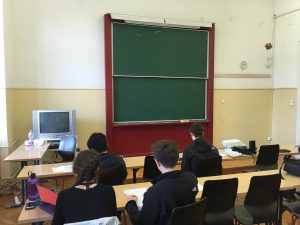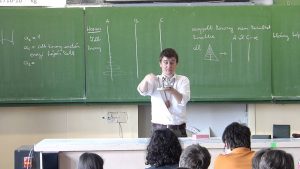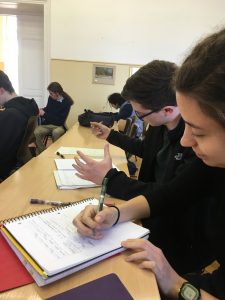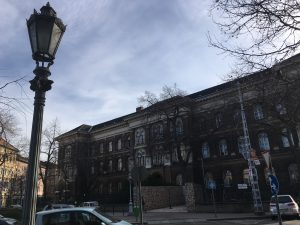Good news! I think that my midterms were successful, so I’ll probably be keeping all of the courses in my schedule. Here’s the rundown:
- Combinatorics 1 (Dezső MIKLÓS)
- Mathematical Problem Solving (Sándor DOBOS)
- Introduction to Topology (Ágnes SZILÁRD)
- Introduction to Mathematical Cryptography (Péter MAGA)
- Intermediate Hungarian
I know most of you are thinking, They offer topology? I wish I could take that! or Combinatorics?! what a lucky duck he is! or I want one of these awesome Hungarian last names!
These are all things that I’m excited about too. And while you probably know all that you need to know about asymmetric cryptographic systems already, I thought that you might appreciate a short review of what my classes entail. Below are some descriptions, as well as some sample problems from the first couple weeks of each course:
Combinatorics 1
The goal of this class is to explore the various ways to count possibilities. We talk a lot about putting hats on people, buying candy and ice cream, and placing people on committees. One of the reasons I like this class is because there are several ways to approach every problem. Depending on how you choose to group objects, you can come up with very different formulas, which I find exciting.
Our professor happens to be the director of BSM, Dezső Miklós, who strides into class five minutes late every day and immediately begins writing on the chalkboard without consulting notes. This is very common for our Hungarian professors, I’ve come to realize. I guess the math is just so ingrained in their psyche, they can pull a lesson plan out of their heads.
Combo Problems
1) How many ways are there to place 1×2 dominoes to exactly cover a 2×10 rectangle?
2) The 5 players of the Chicago Bull are all of distinct heights. In how many different ways can they enter the court if no player is placed between two others both higher then him? Generalize for n players!
Mathematical Problem Solving
This is one of a few courses that make BSM unique from any other undergraduate math program. In this class we explore strategies we can use to solve problems across mathematics. Each week we tackle a different field. One week we looked at divisibility, another week we solved geometry problems, now we are considering problems that involve perfect squares (like 1 = 12, 4 = 22, 9 = 32, or 16 = 42).

A clay flute like Dobos’
My professor, Sándor Dobos, is also one of the coaches of the Hungarian Math Olympiad team, a group of high school students that competes every year in the International Math Olympiad competition against over a hundred other countries. You can tell that he is loves every field of math. He gets so animated over each proof and reveals the solution to every problem as if it were the end of a murder mystery. He also plays his ocarina (clay flute) to announce the beginning of every problem.
MPS Problems
3) Prove that every positive integer has a multiple in the form 11…1100…0 (some 1’s followed by some 0’s)
4) Let A and B be points and m be a line. How do you find the point P on m such that AP + PB is a minimum.
Introduction to Topology
Topology, says Professor Szilárd (see-LARD), is “seriously exciting.” On our first day of class, she described topology as “rubbersheet geometry.” Unlike in the field of geometry, in topology any two shapes are equal if they can be deformed into another by twisting, compressing, or stretching, as if they were made of rubber. So, all triangles are topologically equivalent, as are squares and circles, spheres and cubes, and all sorts of lines. However, the torus, with its hole, is not equivalent to a sphere.
We calculate that two objects are topologically the same by finding special functions called homeomorphisms that map one objects onto the other. This semester, we’ve used homeomorphisms to show that the sphere minus a point is essentially a plane, and that gluing two one-sided Mobius strips together produces a cool object called a Klein bottle, among other equivalences. Topology is one of the foundational fields in mathematics, so I’m glad to finally be receiving an introduction.
It’s hard to find an introductory problem that doesn’t involve a number of definitions, so maybe this will provide a taste of the terminology:
5) In class we showed some cases of the fact that in R all open intervals (a, b) (where a, b can be ±∞ as well) are homeomorphic. Now consider [0, 1) and (0, 1) of R. We certainly know they are bijective as both are uncountable. Find an actual bijection between the intervals [0, 1) and (0, 1) of R.
Introduction to Mathematical Cryptography

Not exactly how it works, but looks cool.
This is probably the sexiest course title in my schedule. Cryptography sounds mysterious and complicated, but it is simply the study of how to send private messages. How can we ensure that a message can get from Alice to Bob without Eve, the eavesdropper, figuring out what the message is? In ancient times, the rudimentary Caesar cipher or simple substitution cipher were sufficient to encode and decode messages secretly. But with the advent of computers, cryptographers have turned to rigorous mathematical algorithms to create cryptographic systems that can securely transmit large amounts of data.
The class has drawn upon other fields I have studied, such as discrete math and abstract algebra, which I thought would never be all that practical. Just goes to show there is almost always an application of math!
Cryptography Problem
6) Crack the following Caesar cipher: iai! oazsdmfgmfuaze! zmftmzuqx iagxp nq ea bdagp ftmf kag eaxhqp ftue oubtqd.
Intermediate Hungarian
Slowly, but surely, I am learning Hungarian vocabulary. For whatever reason, my Spanish keeps coming to me instead of Hungarian. Oh well, maybe I can try Spanish at the local store.
I promise to post again soon!
Nathaniel







